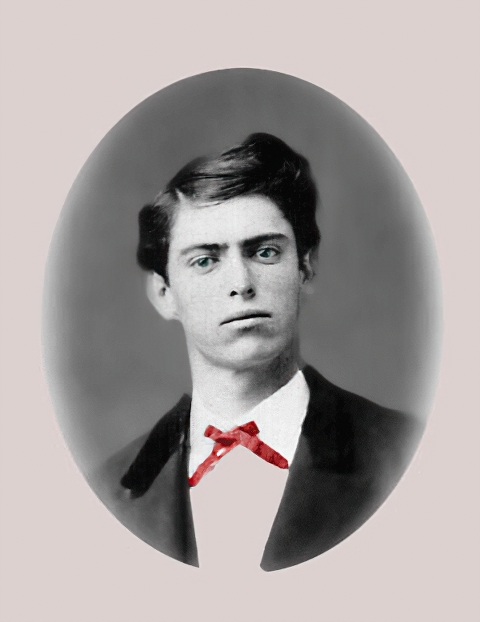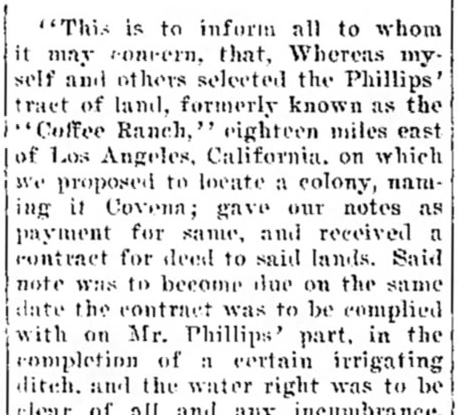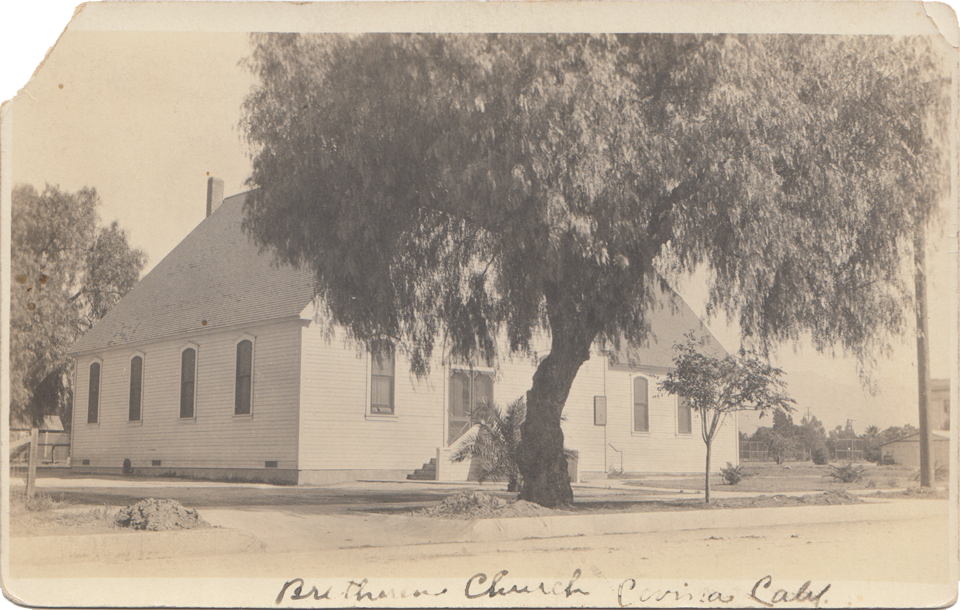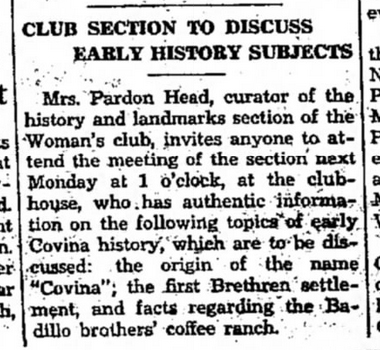Back in 2018, the late Glenn Reed told of finding new information about how Covina originally got its name: a previously unknown contemporary account that the elder historian believed credible enough to make the following statement:
I think that is a better story for the naming of Covina than any that I have heard, and besides, it is an account from someone alive at the time; I am accepting it.1
And now, it just so happens that I've found corroborative evidence for that alternate take on Covina history.
First, though, let me quote the traditional story that's been retold in virtually every recounting of the city's past: that it was Joseph Phillips' surveyor Fred Eaton who authored the name.
...Mr. Eaton observed that because of the embracing mountains and hills the subdivision seemed to lie in a cove. He noted, too, the productive vineyards that had been planted by the settlers. From cove and vine he formed the word "Covina," cove of vineyards, and it struck him that this would be a good name for the new town.2

Frederick S. Eaton in the mid-1880s when the Phillips Tract was surveyed. He was elected City Surveyor of Los Angeles in 1885.3,4
Image source: Hal Eaton on Find a Grave.
It is factually true that the first time the word "Covina" ever saw print was on the original plat map of the Phillips Tract. But is there actual documentary proof that Eaton was the true author of the name? Or could this be a case of a tale that's been told so many times that people simply assume it's a historical fact?
It turns out, however, that there are other long-forgotten stories of how Covina was christened, and one of those is backed with documentary evidence: that the name originated with a group of German Baptist Brethren, and that their original spelling was "Covena"5...

The first people to express interest in buying Joseph Phillips' "Coffee Ranch"5 were Chicago-based6 members of the Brethren Church, popularly referred to at the time as "Dunkards" or "Dunkers." They wanted to establish a religious colony in southern California–specifically in what was then known as the Azusa Valley–which they initially intended to call "Pilgrims Home."2,5
In late 1883, they entered into a contract to buy the entire 2,000 acres of Phillips' holdings, on condition that ample water be supplied to the lands.2,3 Unfortunately, when months passed and the promised water was not forthcoming, the deal fell through, and perhaps predictably, threats of litigation soon followed.2,6
Among the public brickbats flung back and forth between Phillips and the Dunkards was a circular authored in 1885 by one of the principals in the land deal gone sour: Brother B. A. Hadsell. Entitled "A Warning," it contained the following noteworthy passage:
...Whereas myself and others selected the Phillips' tract of land, formerly known as the "Coffee Ranch," eighteen miles east of Los Angeles, California, on which we proposed to locate a colony, naming it Covena;...5

Covina Argus, May 28, 1930.
Despite the different spelling, this is a published claim that the Brethren themselves named the place. Brother Hadsell gave no explanation why Covena was chosen, but I quickly noticed how adding "-nt" to the end produced the word "Covenant"–quite fitting for a religious settlement. Additionally, "covena" is an actual word in Latin and translates to "circle" in German, which perhaps has some textual significance to the German Baptists.
Finding this mention in the Argus provided corroboration for the story previously related by Glenn Reed: that, according to Clara Eckles Warner (1874-1966), the Dunkards had christened the town. However, the name given in Miss Eckles' account1 was not "Covena"...
The Dunkard Brethren were colonizing Covina, only that wasn't its name yet. One day Phillips called father over to do some surveying and to give some advice. It seemed the colony of Brethren wanted to name their section, "Los Covinas." They thought it was Spanish for "The Little Cove." "Los" was the only Spanish part of it, and Mr. Phillips didn't want to hurt their feelings by pointing out their mistake. Besides, there wasn't any cove present! So a compromise name was suggested, that of "Covina," the leaders were consulted, and the town named before it had time to catch its breath.1
This version also attributes the original naming to the Brethren elders, but with followup input by Joseph Phillips, not Fred Eaton.

The old Brethren Church on Puente at Third Street, c.1919. A rear corner of Covina Union High School can be seen at far right.
A third alternative origin story comes from Clara Eckles' mother, pioneer Mary Fuller Eckles (1850-1929), who was known during her lifetime as the "Mother of Covina." The James Eckles family arrived in southern California in 1876 and settled north of the Citrus post office in 1881,7 before either Phillips or Eaton ever set foot on the place.
Thereby being a bona fide eyewitness to local history as it unfolded, Mary Eckles related:
...the community was without a name and a number of ladies [emphasis mine] decided upon the word Covina as typical of the cove or valley and the vineyards that covered a large portion of the cultivated area."8
Admittedly, "a number of ladies" is vague, her statement makes no mention of the Brethren, nor does it give a precise date, but in the very early 1880s, prior to the opening of the Phillips Tract, the total population in the vicinity of the Citrus post office was only two or three dozen people, and if any scuttlebutt were going around–such as a new name for her community–I think it can be reasonably assumed that Mary Eckles heard about it, and committed its origin to memory.
So whether it be Covena, Covinas or Covina, the etymological seed had evidently already found fertile soil among those who were living in the area by the time out-of-towner Fred Eaton came along in December, 1884.9
Of course, when it came right down to it, it was Joseph Phillips himself who had the final say what his town would be named. Initially, he might have had something self-commemorative like "Phillipsburg" in mind, but that just doesn't have the lyrical ear-appeal of "Covina." Besides, his Cornelia fancied it, and what good husband wouldn't wish to please his wife?
So in conclusion, all presently available evidence considered, I'm now with Glenn Reed on favoring the Brethren colony origin story for the naming of Covina.

Postscript: Harkening back to Covina's first historian Harriett Head for a moment: this Argus clipping from 1930 tells of a talk she was planning to give to the Covina Woman's Club. Intriguing keywords here: "authentic information," "origin of the name 'Covina'," "Brethren settlement," "coffee ranch."10 Sounds familiar! Perhaps needless to say, I would love to travel back in time and attend that meeting. I suspect I'd find out I wasn't the first person to ever put 2 and 2 together in this matter.

Covina Argus, December 19, 1930.

References:
1 Reed, G. 2018. The Naming of Covina, The Covina Citrus Peal, Covina Valley Historical Society, June 2018, p.4.
2 Pflueger, D. H. 1964. Covina: Sunflowers, Citrus, Subdivisions. Castle Press, Pasadena, California, 372pp.
3 Los Angeles Herald, December 23, 1885, p.5.
4 Eaton, H. 2012. Frederick "Fred" Eaton (1855-1934), Find a Grave memorial page.
5 Covina Argus, May 28, 1930, p.8.
6 Los Angeles Sunday Times, March 28, 1886, p.6.
7 Covina Argus, September 6, 1929, p.1.
8 Covina Argus, February 12, 1926, p.2.
9 Surveyor name and date notation on the original plat map of the Phillips Tract (1884).
10 Covina Argus, December 19, 1930, p.1.
Newspaper clippings: Newspapers.com.
No comments:
Post a Comment
To post a comment, you must login to this page with the Google Chrome web browser. That is the only way that works now.